108 Search Results for visual schedules
October 31, 2022
by Carole Zangari -
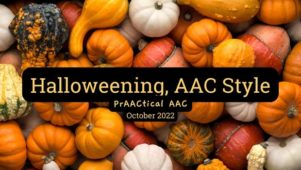
Happy Pumpkin Day! We’re reprising this post for anyone in need of some additional resources. Holidays are special and Halloween is a favorite among many. As much fun as it is to dress up and get candy, though, there are lots of ways that Halloween can be stressful for AAC learners. From the change in routine, to the costumes and scary decorations, to talking with neighbors and other less familiar communication partners, to the overabundance of sugar, there are lots of ways in which Halloween can trip us up. If the AAC learners in your life celebrate Halloween, Fall Festival, Harvest Parade, or any other celebration with similar traditions, we SLPs can help them to have a positive experience. Here are some ideas. Use a social narrative to prepare everyone for what to expect on and around Halloween. Read them often in the weeks leading up to the school dress-up parade,... [Read More...]
September 20, 2021
by Carole Zangari -
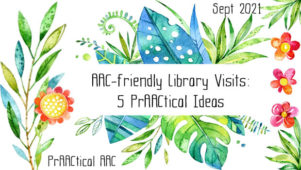
The community of AAC practitioners and families includes many people who have strong connections to their school or community libraries. In today’s post, we share some thoughts and resources on making library visits more accessible and engaging to those with AAC needs. Social narratives are a wonderful, evidence-based way to help AAC learners prepare for the experience of visiting the library. These work best when the pictures and text are customized to fit the specific library situation that the AAC learner will encounter. Here are some examples. Nicole Caldwell’s example of a social narrative Lancaster Public Library Social Narrative for Children Social Narrative for Teens Take a video tour of the library, like this one from Powell River Library. If your local library doesn’t have an online video tour, suggest that they create one or, if you’re feeling ambitious, create your own. Create a visual schedule or picture checklist for... [Read More...]
September 2, 2021
by Carole Zangari -
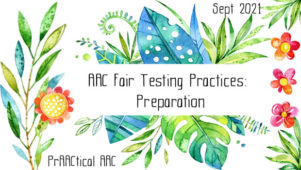
In an earlier post, we talked about the difficulties that people who use AAC experience when they have to participate in tests or other assessments for educational or therapeutic purposes. (You can see that post here.) One approach to addressing these challenges is for key stakeholders to come together and develop a set of guidelines that teachers, therapists, and others can use when they need to administer an assessment. Today, we’ll look at some of the guiding questions that teams can use to develop these Fair Testing Practices. The idea here is that AAC users, families, professionals, and other team members can come together to discuss a number of specific issues regarding preparation, materials, means of answering questions, etc. Later in the series, we’ll talk about ways to facilitate meaningful participation by individuals who use AAC but are still developing their communication and language skills. For the time being, though,... [Read More...]
November 9, 2020
by Carole Zangari -
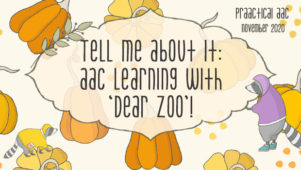
Ready for another post with book-related ideas for supporting core vocabulary learning in preschool classrooms? We’re excited to welcome Jeanna Antrim and Maggie Judson back to these pages with another guest post the TELL ME About It series. Today, they share ideas for core vocabulary experiences with an old favorite, Dear Zoo.If you’re in search of ways to support preschool teachers who are implementing the TELL ME program with their young students, this post is for you. There are quite a few resource links embedded in this post, ready for you to download. Maggie and Jeanna are speech-language pathologists who work in the Assistive Technology Department for the Belleville Area Special Services Cooperative (BASSC) in southern Illinois. They are AT/AAC facilitators and provide evaluations, direct therapy, consultations, and trainings with school teams. ::::::::::::::::::::::::::::::::::::::::::::::::::::::::::::::::::::::::::::::::::::::::::::::::::: TELL ME About It: AAC Learning with ‘Dear Zoo’! TELL ME About The Book The third book... [Read More...]
October 22, 2018
by Carole Zangari -
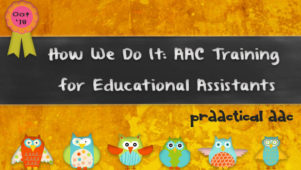
We’ve been focusing on training communication partners recently and today we’re focusing specifically on paraprofessionals/educational assistants. Our guest post is authored by SLPs Corinna Duffitt, M.Sc., RSLP (practicing for 21 years, 14 years in AAC) and Jennifer Wiegert, M.A., CCC-RSLP (practicing for 21 years, focusing on AAC for the past 6 years). They are colleagues on an AAC team with 4 other SLPs in a large school district in Surrey, BC, Canada. Their school district consists of 101 elementary schools and 20 secondary schools. Corinna and Jennifer are both passionate about giving children a voice and letting that voice uncovers their potential. They recently joined their private practice endeavours, outside of their public school positions, to form Chickadee AAC Communication Services. You can find them on Instagram (@chickadeeaacslps or #chickadeeaac), check in on their website, and/or follow them on Facebook. :::::::::::::::::::::::::::::::::::::::::::::::::::::::::::::::::::::::::::::::::::::::::::::::::::::::: AAC Training for Educational Assistants Some of the challenges we encountered... [Read More...]
August 10, 2017
by Carole Zangari -
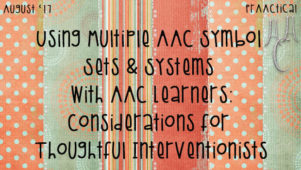
PCS, Pixons, Minspeak symbols, Smarty Symbols, Symbol Stix, CoughDrop Symbols, ARASAAC symbols, Mulberry symbols, Lesson Pix, Sclera symbols, and more. In terms of AAC symbol options, we are living in plentiful times. It isn’t uncommon to see situations like Jonah’s. On a typical school day, Jonah is likely to encounter at least three types of pictures for the same words. He has Smarty Symbols on his AAC app and a classroom core board with PCS, and is using instructional materials using Symbol Stix. These are each great ways of visually representing language, but here’s something to think about: Does it help or hurt Jonah to have 3 different pictures for the same word? There are many options in symbol sets and systems, and each has its own strengths and weaknesses. Here are some things to think about as you and your team are making these decisions. There is no empirical... [Read More...]
November 7, 2016
by Carole Zangari -
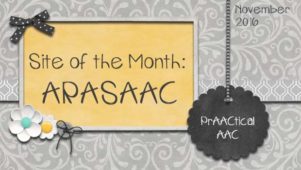
Symbols, templates, software, tools, and more. That’s what you’ll find on the November PrAACtical Site of the Month: ARASAAC, the Aragonese Portal of Augmentative and Alternative Communication. Supported by the Department of Education, Culture and Sports of the Aragonese Government and the General Directorate of Innovation, Equality and Participation, this award-winning site has been serving the AAC community for over two decades. They may be best known for the picture symbols that they share so freely, which allows professionals, users of AAC, and families to create free resources in Catalan, Euskera, English, French, German, Italian, Galician, Portuguese, Spanish, and more. The online tools section has a variety of things to explore including tools to make communication boards, animations (gifs), schedules and calendars, custom symbols, and games. There are also wonderful resources for Spanish Sign Language in pictures and videos. There is also a Materials Exchange section where you can download communication... [Read More...]
June 1, 2016
by Carole Zangari -
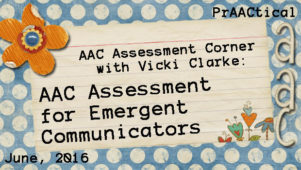
Today, we welcome back Vicki Clarke with more helpful information on conducting AAC assessments. If you work with individual who are at the early stages of communicative development, this post is for you! :::::::::::::::::::::::::::::::::::::::::::::::::::::::::: Some of my most favorite students are those who, at first, may not seem to notice me at all. Sometimes these students seem to exist in their own worlds. They don’t seem to respond in ways we would expect: looking, attending, listening, or gesturing. They may have a diagnosis of Autism, significant developmental delay, epilepsy, or any number of syndromes. I love these kids, and unfortunately, these are often the students who don’t get referred to me. Sometimes it takes years of working in a district before I get to see students with significant developmental delays. These children are typically served in classrooms for students considered to be severe/profound or multi-handicapped. Honestly, I usually get the... [Read More...]
October 27, 2015
by Carole Zangari -
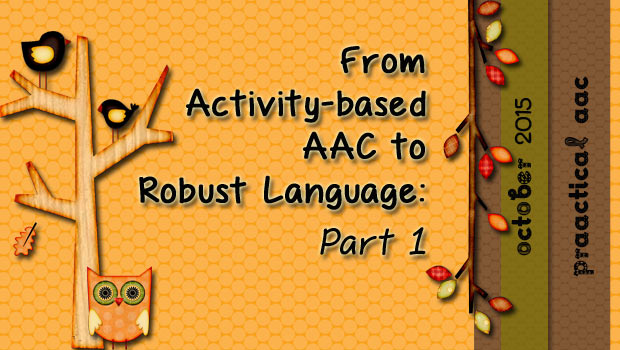
As far as I can tell, most AAC learners are taught by people who don’t specialize in AAC. Their school SLPs may have caseloads of 50, 60, 70, or more students with IEPs, 90% of whom have goals for articulation, language, and fluency. Their classroom teachers serve students whose disabilities range from none at all, to dyslexia to cerebral palsy, to significant intellectual disabilities, and everywhere in between. In all likelihood, neither group had much AAC training. What little AAC they know, they’ve picked up on their own from reading, going to workshops and conferences (usually self-funded), talking to colleagues, and exploring online resources. Many times, their first foray into AAC is with things like choice boards and visual supports, such as daily schedules and first/then boards. From there, they may begin labeling the environment with pictures symbols (e.g., ‘table’ on the table, ‘on/off’ near the light switch), using mini-schedules... [Read More...]
October 15, 2015
by Carole Zangari -
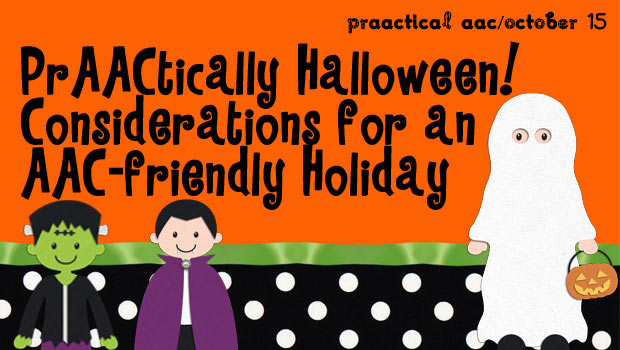
Holidays are special and Halloween is a favorite among many. As much fun as it is to dress up and get candy, though, there are lots of ways that Halloween can be stressful for AAC learners. From the change in routine, to the costumes and scary decorations, to talking with neighbors and other less familiar communication partners, to the over-abundance of sugar, there are lots of ways in which Halloween can trip us up. If the AAC learners in your life celebrate Halloween, Fall Festival, Harvest Parade, or any other celebration with similar traditions, we SLPs can help them to have a positive experience. Here are some ideas. Use a social narrative to prepare everyone for what to expect on and around Halloween. Read them often in the weeks leading up to the school dress-up parade, party, and the big day itself. More Halloween social narratives can be found at Therapics,... [Read More...]









